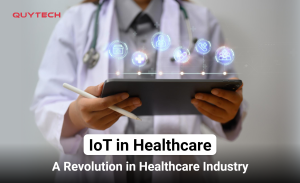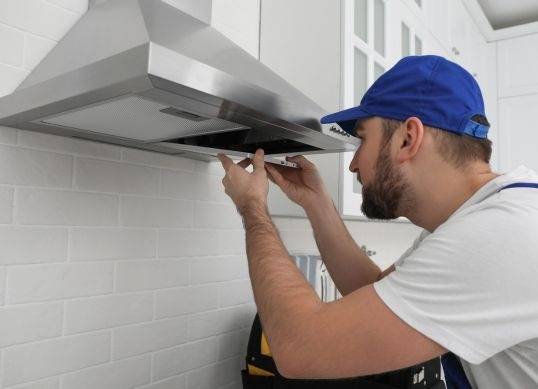
IoT in healthcare is more than just a technological trend but it is reshaping how patient care is delivered, monitored, and managed.
Leading hospitals, medical facilities, and health service providers are adopting the technology to enhance operations and improve patient care.
According to statistics, the global Internet of Things in healthcare market size was valued at $44.21 billion in 2023. Experts predicted that it will grow at a compound annual growth rate (CAGR) of 21.2% from 2024 to 2030.
Explaining IoT in healthcare, this blog tells you IoT’s overview, key applications, implementation process, and benefits of implementing it. So, let’s start.
Overview of IoT in Healthcare
The Internet of Things (IoT) is a network, consisting of interconnected devices that communicate and share data with each other via the Internet in real-time.
In the healthcare sector, it is also known as IoMT (Internet of Medical Things). IoT devices, such as wearable health monitors, connected medical equipment, smart hospital systems, and more, are connected with each other. It helps healthcare experts gather data and gain insights into patients’ health, improve patient care, and more efficient healthcare operations.
Let’s talk about the use cases of IoT in healthcare in detail.
Key Applications of IoT in Healthcare
The following are the key applications of the Internet of Things (IoT) in the healthcare sector.
1. Remote Patient Monitoring (RPM)
Healthcare professionals use Internet of Things (IoT) devices to monitor patients’ vital signs and health metrics remotely.
These devices collect and share data in real-time that helps doctors to detect potential health issues in the early stages, and take the required course of action on time.
Also, IoT reduces the need for patients and elderly people to visit hospitals frequently, saving their time and effort, and eliminating overcrowding in healthcare centers.
2. Smart Hospitals
IoT technology plays an important role in transforming traditional hospitals into smart hospitals. These smart hospitals leverage IoT-enabled devices, machines, and tools that optimize hospital operations.
These include integrating automated systems that help in managing inventory, patient flow, and energy usage and lead to improved efficiency and reduced operational costs.
3. Personalized Treatment
IoT collects and shares patients’ data with doctors and healthcare professionals.
They analyze data and create personalized treatment plans. Wearable devices and smart sensors monitor patients around the clock, and enable healthcare providers to tailor treatment plans based on individual patient needs.
4. Telemedicine
Another key role of IoT in healthcare is enhancing telemedicine by enabling remote consultations and diagnosis.
The best mobile app development company states that doctors leverage IoT-powered devices to monitor patients in real-time and provide required consultations remotely without needing to visit patients physically.
IoT makes healthcare services more accessible and effective, especially in areas where there are no proper healthcare centers and medical facilities.
5. Medication Management
IoT solutions also help in effective medication management as these solutions send reminders to patients to take their medications on time.
Smart pill dispensers and connected apps ensure that the patients take medication as per the prescribed treatment plans, reducing the risk of complications from missed doses.
6. Emergency Response Systems
Last but not least, IoT devices also help in providing real-time location tracking and vital information about the patient to responders in case of emergencies. This enables responders to act swiftly and provide necessary care to save lives.
These applications of IoT in healthcare not only enhance patient care but also contribute to more efficient healthcare systems, leading to better connected and responsive healthcare environment.
How to Implement IoT in the Healthcare
Now, let’s discuss the process of effectively implementing IoT in healthcare facilities.
1. Define Clear Objectives
The first step to implementing IoT in healthcare is to identify the specific healthcare challenges you aim to address with IoT, such as improving patient monitoring, enhancing operational efficiency, or reducing costs.
Also, you need to hire mobile app developers with expertise in IoT technology, as IoT implementation is a complex task and requires deep knowledge and understanding of the technology.
2. Choose the Right IoT Devices and Sensors
After that, choose the right IoT devices and sensors based on the specific needs of the healthcare facility.
These devices must be compatible with existing healthcare systems and can be easily integrated with EHRs and other medical software.
Also, you must ensure that the devices and systems you are picking must comply with the industry standards like HIPAA.
3. Develop a Robust IoT Infrastructure
Once you get the devices, develop a reliable and secure network infrastructure to support the seamless transmission of data between IoT devices, healthcare providers, and cloud systems.
Moreover, you must facilitate real-time data access and enable advanced analytics by integrating IoT devices with cloud platforms to store, manage, and analyze vast amounts of healthcare data.
4. Ensure Data Security and Compliance
As your IoT systems deal with sensitive patient data, it is necessary to implement security measures, such as strong encryption, multi-factor authentication, and secure data transmission protocols to protect data from potential cyber threats.
5. Integrate with Healthcare Systems
After implementing security measures, integrate IoT data with Electronic Health Records (EHR) systems to provide healthcare professionals with real-time patient information.
Furthermore, you need to ensure that the IoT devices in your healthcare facility can communicate and work seamlessly with other medical equipment and healthcare IT systems, creating a well-connected IoT-driven healthcare ecosystem.
6. Monitor and Evaluate Performance
Post-integrating IoT devices with the healthcare systems, regularly monitor their performance to ensure they are functioning as expected.
You can also take feedback from healthcare providers and patients to refine and improve the IoT implementation.
7. Scale the Solution
Once you start getting the desired results, gradually scale the IoT solution across the healthcare facility or network. However, you must ensure that the infrastructure can handle the increased load.
Therefore, by following these steps, healthcare organizations can successfully implement IoT technology to improve patient care, streamline operations, and enhance overall healthcare delivery.
Benefits of Leveraging IoT in Healthcare
The Internet of Things (IoT) offers numerous advantages in the healthcare sector, revolutionizing how patient care is delivered and managed. The top benefits are as follows:
1. Improved Patient Monitoring Care
IoT allows for real-time data collection and immediate response required to enhance patient care. Also, when patients are continuously monitored, the chances of detecting potential health problems increase.
This allows doctors to take necessary steps on time and reduce risks of serious health-related complications.
2. Increased Efficiency and Reduced Costs
By integrating IoT, hospitals can streamline their operations, improve overall efficiency, and save a significant portion of costs.
Moreover, IoT enhances remote patient monitoring and telemedicine, reducing the need for frequent hospital visits, and decreasing healthcare costs for both patients and providers.
3. Data-Driven Insights
IoT-generated data is used by doctors and healthcare service providers to gain insights into patient health trends, treatment efficacy, and operational efficiencies. They use these insights to make better healthcare decisions and strategies for efficient patient care.
Furthermore, IoT also helps healthcare providers predict potential health issues and trends, allowing for proactive management and prevention, by using historical and real-time data.
Conclusion
The Internet of Things (IoT) is a network infrastructure in which various devices and systems are connected with each other via the Internet, and these can collect and share data in real-time.
In healthcare, IoT is used to gather patient data through smart devices and wearables and allow for remote patient monitoring and care. Also, the technology is used to manage hospital operations effectively, saving significant amounts of costs and other resources.
So, if you are ready to implement IoT in your healthcare facility, reach out to a top healthcare app development company, share your requirements, and get your facility equipped with IoT.


